A lexico-grarnmatical
group is a
class of words which have a common lexico-grammatical meaning, common
paradigm, the same substituting elements and possible characteristic
set of suffixes rendering the lexico-grammatical meaning. These
groups are subsets of the parts of speech, several lexico-grammatical
groups constitute one part of speech. Thus English nouns are
subdivided approximately into the following lexico-grammatical
groups: personal names, animal names, collective names ( for people),
collective names (for animals), abstract nouns, material nouns,
object nouns, proper names for people, toponymic names.
Another traditional
lexicological grouping is known as word-families
in which the words are grouped according to the root-morpheme, for
example: dog,
doggish, doglike, doggy, to dog, dogged, doggedly, doggedness,
dog-days, dog-biscuit, dogcart, etc.
3. The theory of the semantic field. Common semantic denominator.
Semantic field
is a closely knit sector of vocabulary characterized by a common
concept (e.g. in the semantic field of space we find nouns (expanse,
extent, surface);
verbs (extend,
spread, span);
adjectives (spacious,
roomy, vast, broad).
The members of the semantic fields are not synonymous but all of them
are joined together by some common semantic component. This
semantic component common to all the members of the field is
sometimes described as the common denominator of meaning,
like the concept of kinship, concept of colour, parts of the human
body and so on. The basis of grouping in this case іs
not only
linguistic but also extra-linguistic: the words are associated,
because the things they name occur together and are closely connected
in reality.
4. Thematic or ideographic groups. Common contextual associations.
Thematic (or ideographic)
groups arc groups of words joined together by common contextual
associations within the framework of the sentence and reflect the
interlinking of things and events in objective reality. Contextual
association are formed as a result of regular co-occurrence of words
in similar repeatedly used contexts.
Thematic or ideographic
groups are independent of classification into parts of speech. Words
and expression are here classed not according to their
lexico-grammatical meaning but strictly according to their
signification, i.e. to the system of logical notions:
tree →
grow →
green;
journey →
train, taxi,
bass →
ticket;
sunshine →
brightly
→
blue →
sky,
5. Hyponymy, paradigmatic relation of inclusion. Hyponyms, hyperonymas, equonyms.
Hyponomy
is the semantic relationship of inclusion existing between elements
of various levels. Thus, e.g. vehicle
includes
car, bus,
taxi; oak implies
tree, horse
implies
animal;
table
implies furniture.
The
hyponymic relationship is the relationship between the meaning of the
general and the individual terms.
A hyperonym
is a generic term which serves as the name of the general as
distinguished from the names of the species-hyponyms. In other, words
the more specific term is called the hyponym. For instance, animal
is a
generic term as compared to the specific names wolf,
dog or
mouse
(these are
called equonyms).
Dog, in
its turn, may serve as a generic term for different breeds such as
bull-dog.
collie, poodle, etc.
Соседние файлы в предмете [НЕСОРТИРОВАННОЕ]
- #
- #
- #
- #
- #
- #
- #
- #
- #
- #
- #
- Размер: 58 Кб
- Количество слайдов: 27
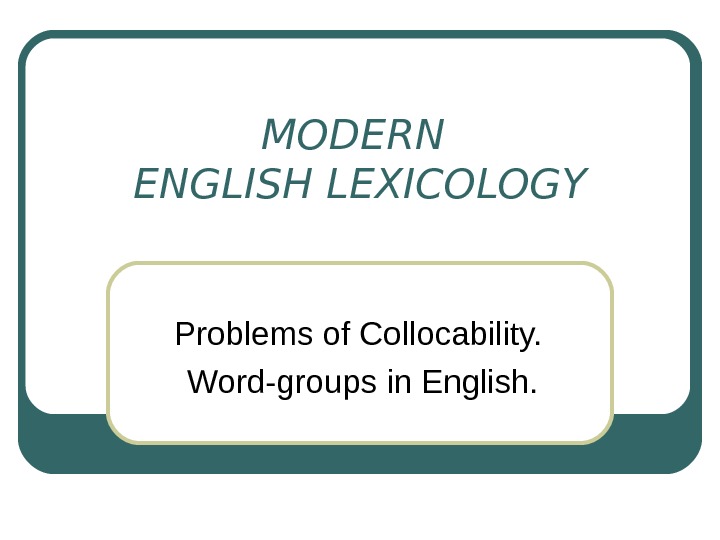
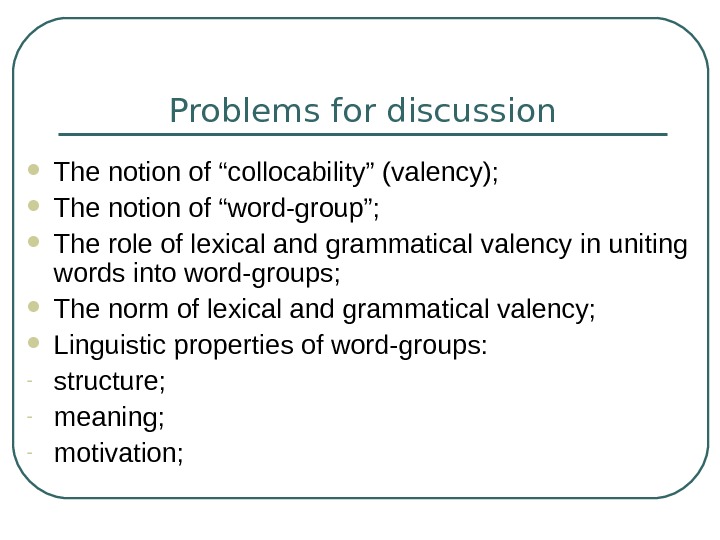
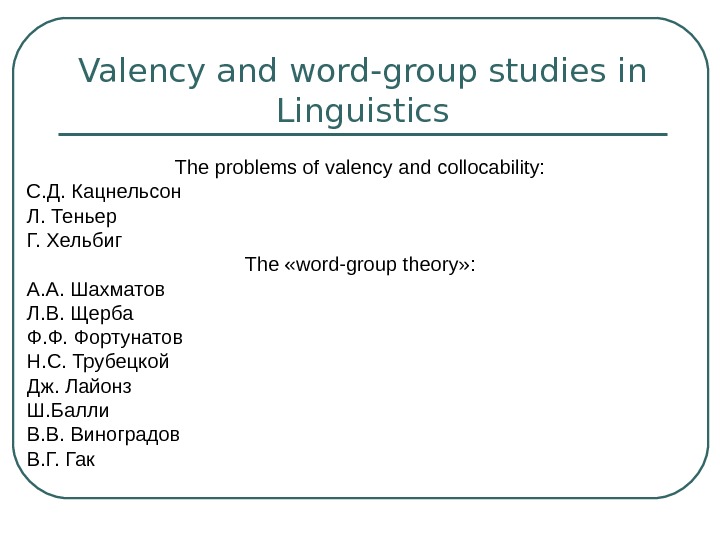
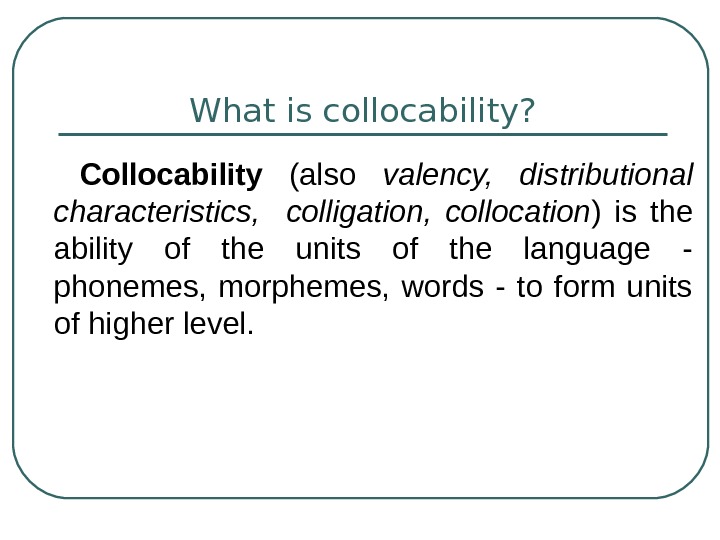
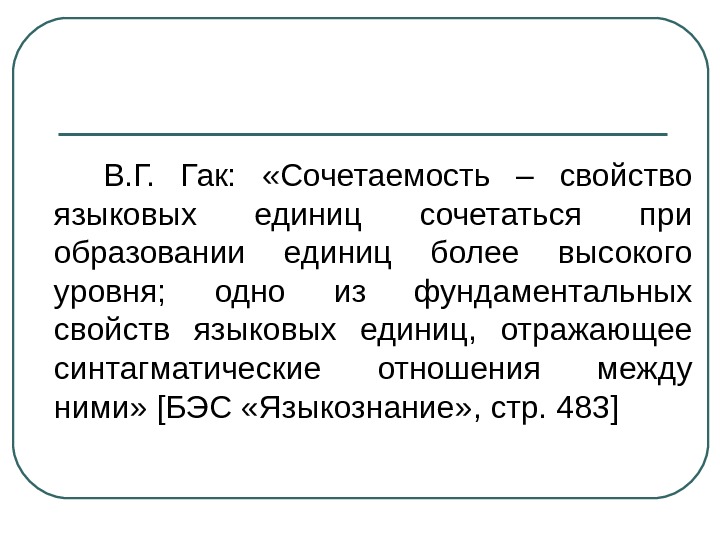

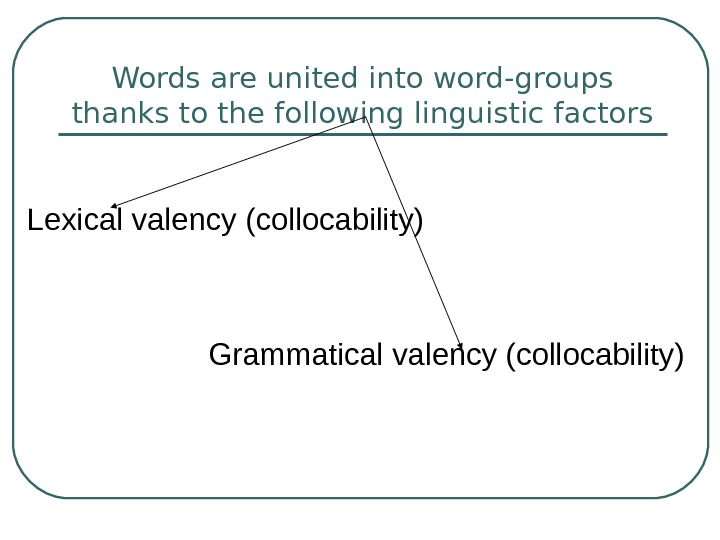
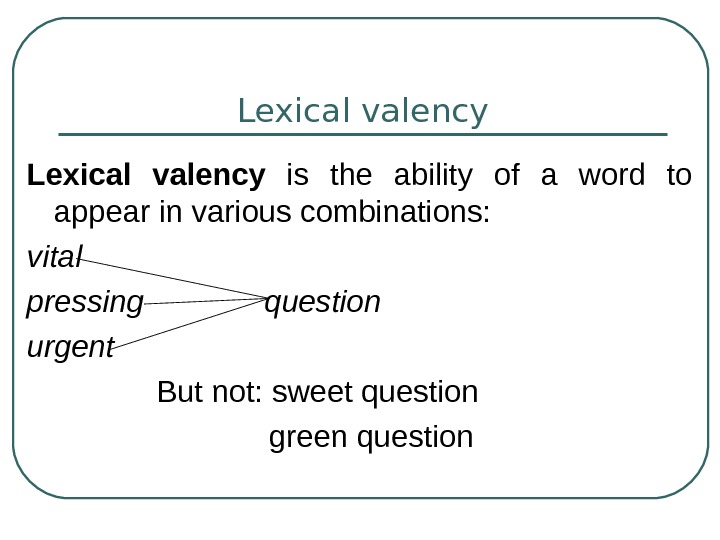
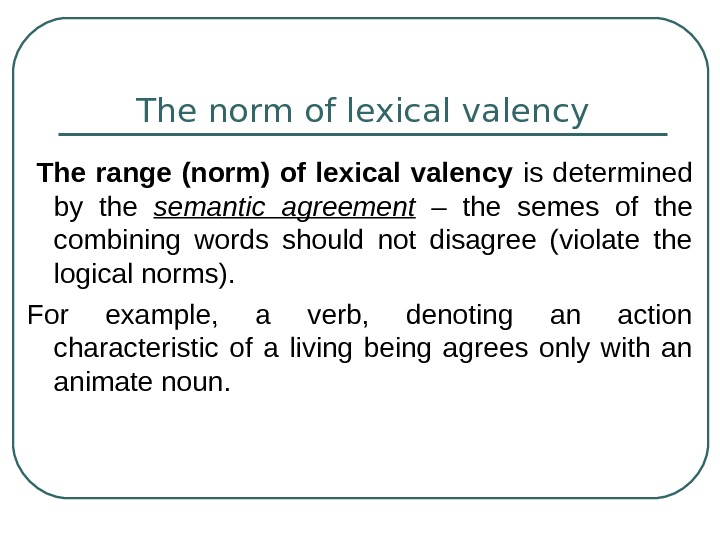
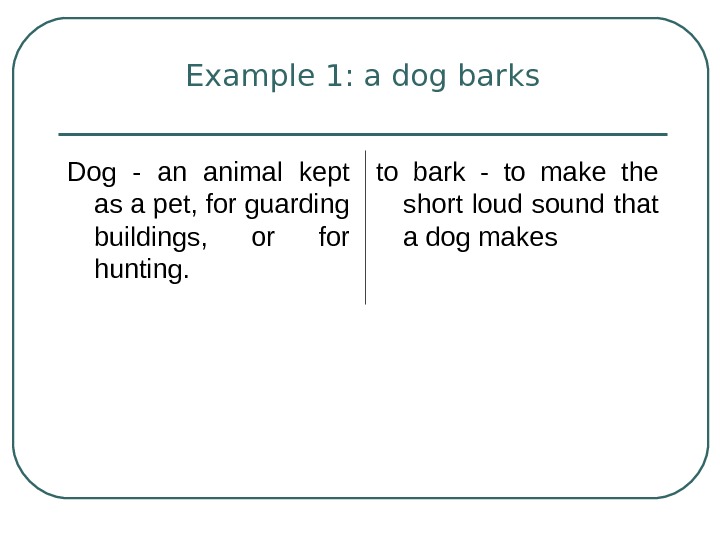
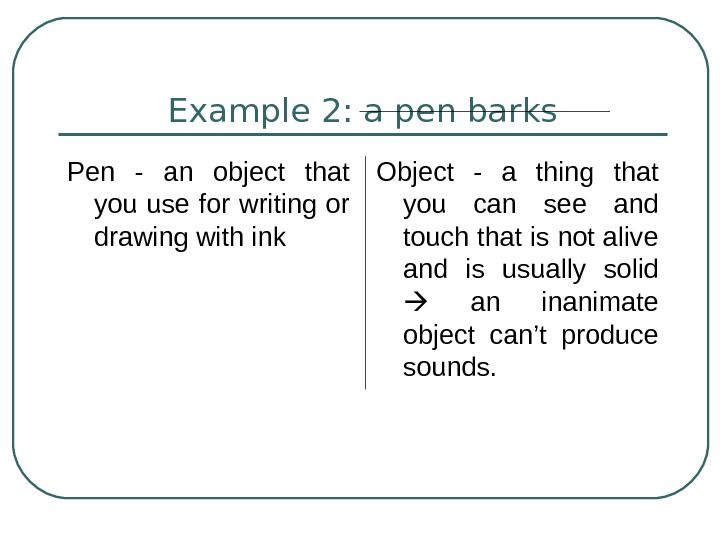
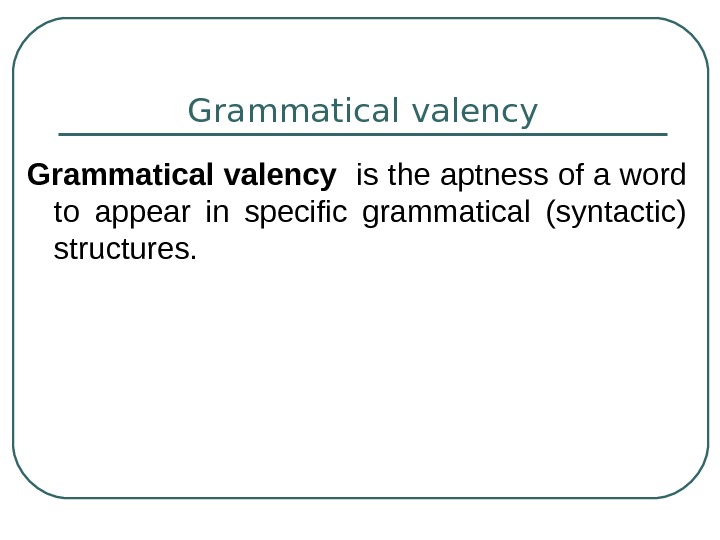
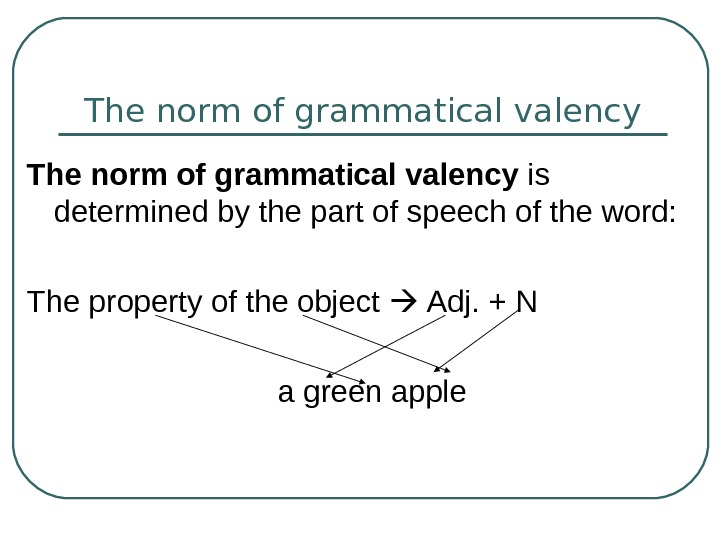
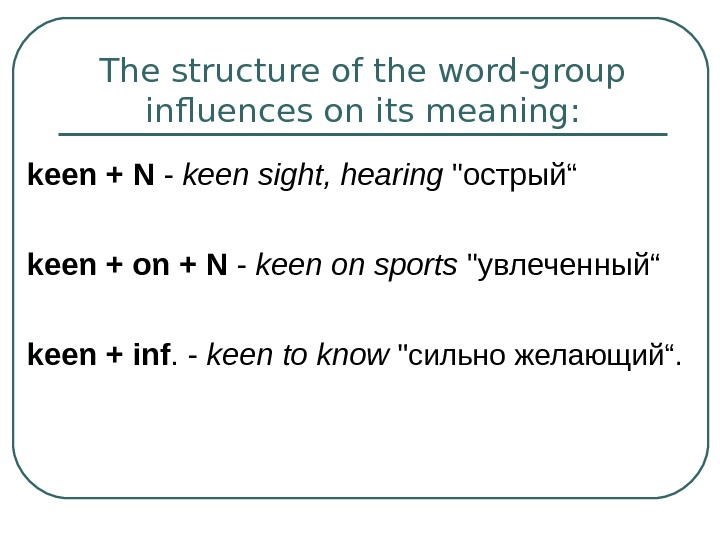
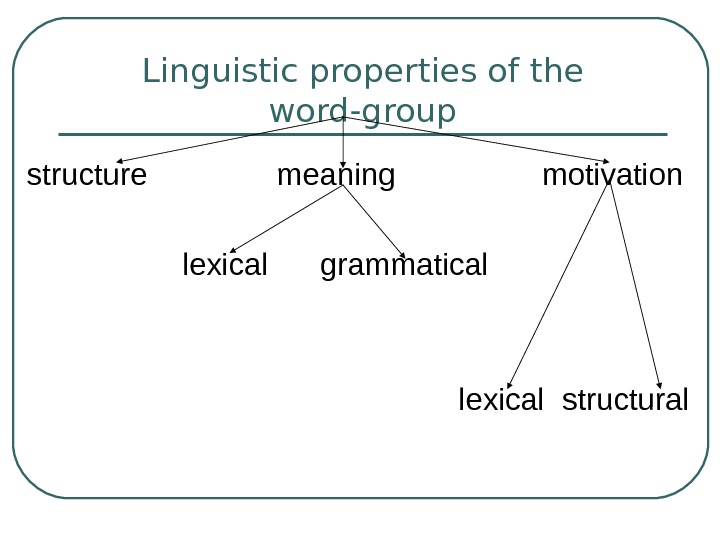
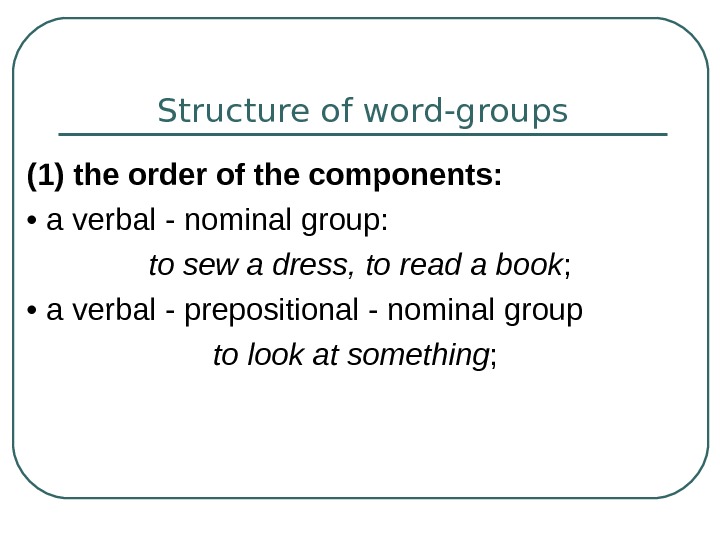
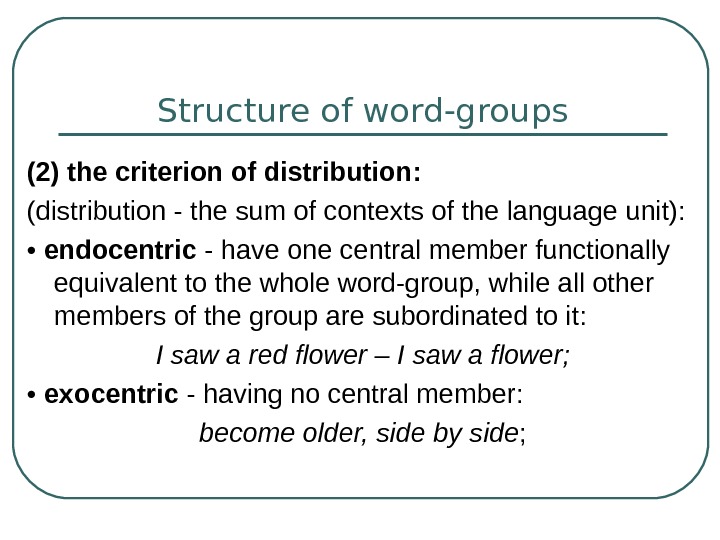
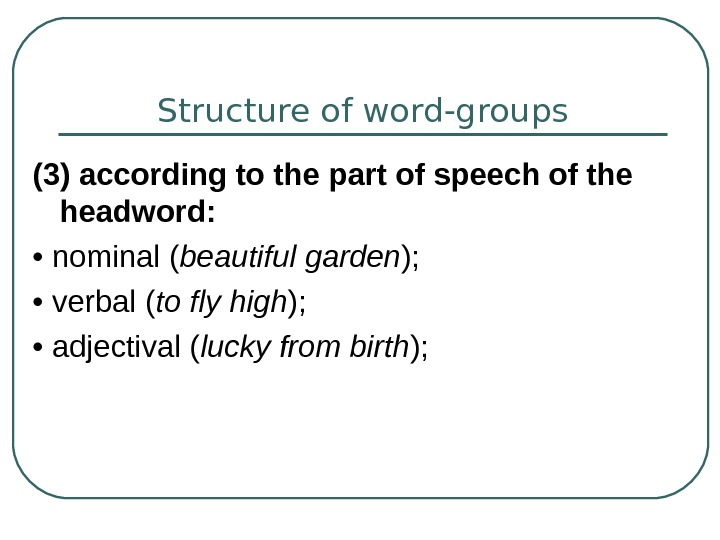
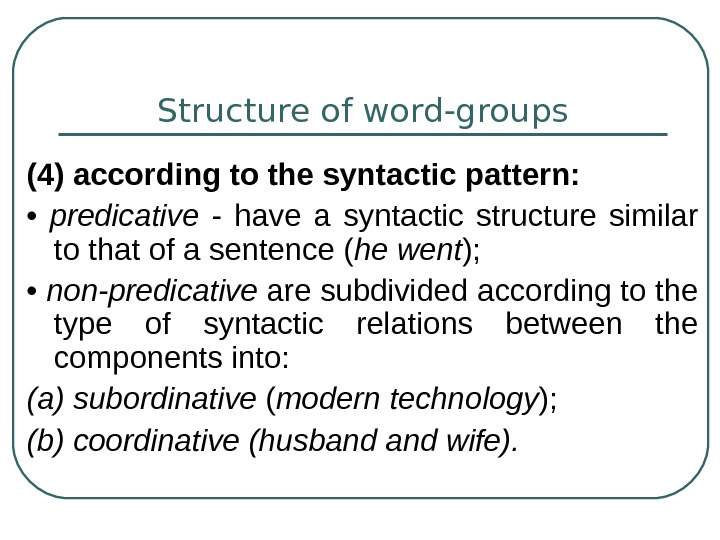

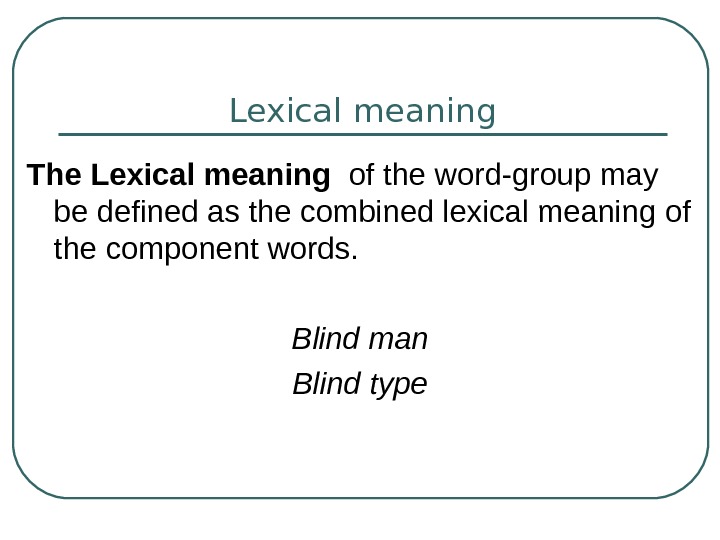
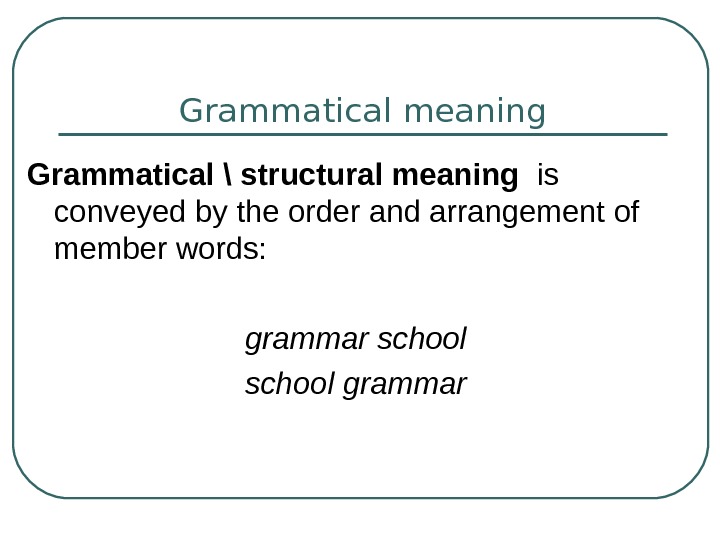
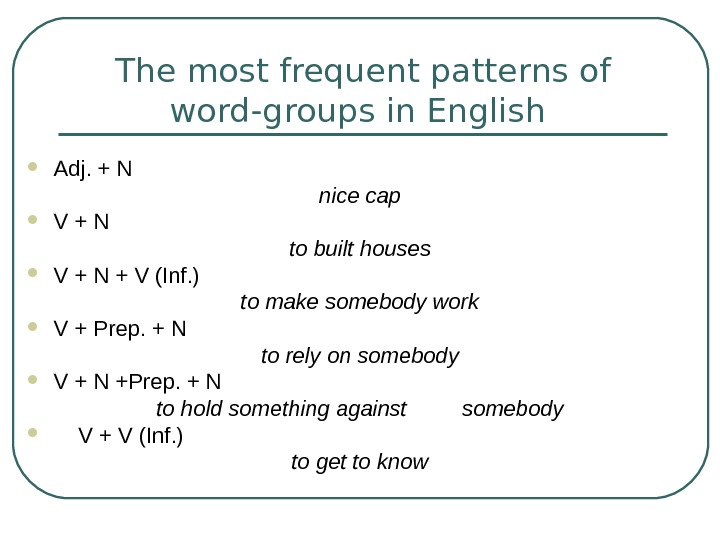
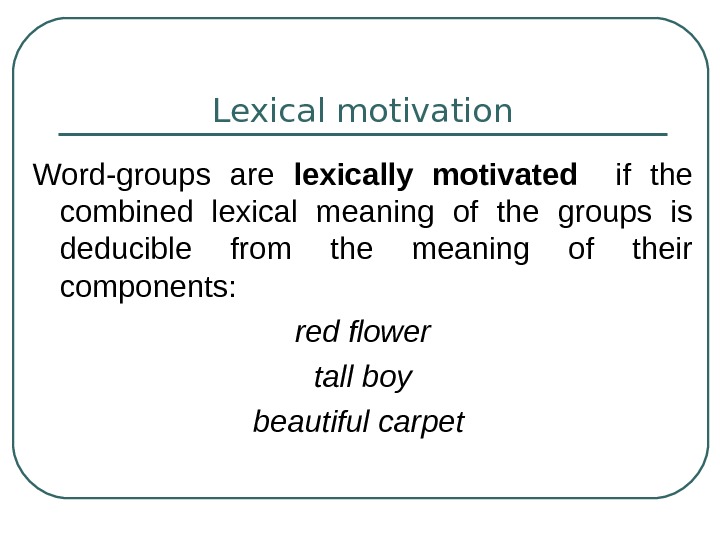
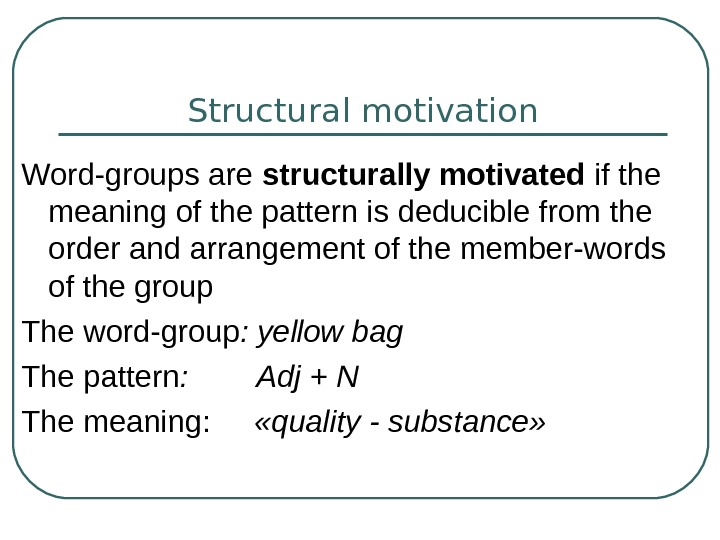
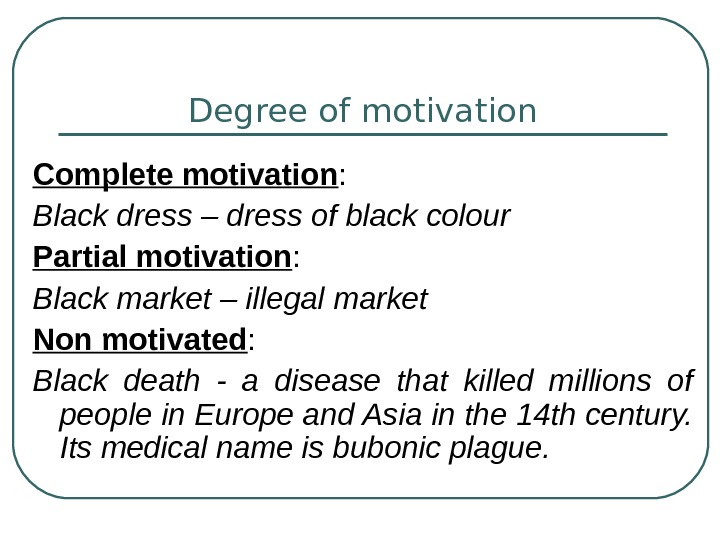
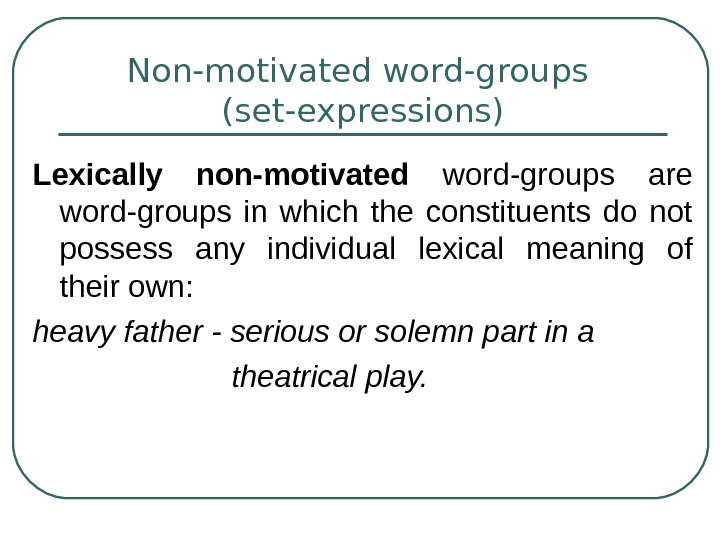
Free word-groups. Definition. Classification.
A word-group is the largest two-facet lexical unit comprising more than one word but expressing one global concept.
The lexical meaning of the word groups is the combined lexical meaning of the component words. The meaning of the word groups is motivated by the meanings of the component members and is supported by the structural pattern. But it’s not a mere sum total of all these meanings! Polysemantic words are used in word groups only in 1 of their meanings. These meanings of the component words in such word groups are mutually interdependent and inseparable (blind man – «a human being unable to see», blind type – «the copy isn’t readable).
Word groups possess not only the lexical meaning, but also the meaning conveyed mainly by the pattern of arrangement of their constituents. The structural pattern of word groups is the carrier of a certain semantic component not necessarily dependent on the actual lexical meaning of its members (school grammar – «grammar which is taught in school», grammar school – «a type of school»). We have to distinguish between the structural meaning of a given type of word groups as such and the lexical meaning of its constituents.
It is often argued that the meaning of word groups is also dependent on some extra-linguistic factors – on the situation in which word groups are habitually used by native speakers.
Words put together to form lexical units make phrases or word-groups. One must recall that lexicology deals with words, word-forming morphemes and word-groups.
The degree of structural and semantic cohesion of word-groups may vary. Some word-groups, e.g. at least, point of view, by means, to take place, etc. seem to be functionally and semantically inseparable. They are usually described as set phrases, word-equivalents or phraseological units and are studied by the branch of lexicology which is known as phraseology. In other word-groups such as to take lessons, kind to people, a week ago, the component-members seem to possess greater semantic and structural independence. Word-groups of this type are defined as free word-groups or phrases and are studied in syntax.
Word-groups are classified according to their syntactical pattern into predicative and non-predicative groups. Such word-groups as he went, Bob walks that have a syntactic structure similar to that of a sentence are termed as predicative, all others are non-predicative ones.
Non-predicative word-groups are divided into subordinative and coordinative depending on the type of syntactic relations between the components. E.g., a red flower, a man of freedom are subordinative non-predicative word-groups, red and freedom being dependent words, while day and night, do and die are coordinative non-predicative word-groups.
The lexical meaning of a word-group may be defined as the combined lexical meaning of the component members. But it should be pointed out, however, that the term «combined lexical meaning» does not imply that the meaning of the word-group is always a simple additive result of all the lexical meanings of the component words. As a rule, the meanings of the component words are mutually dependent and the meaning of the word-group naturally predominates over the lexical meaning of the components. The interdependence is well seen in word-groups made up of polysemantic words. E.g., in the phrases the blind man, the blind type the word blind has different meanings – unable to see and vague.
So we see that polysemantic words are used in word-groups only in one of their meanings.
The term motivation is used to denote the relationship existing between the phonemic or morphemic composition and structural pattern of the word on the one hand and its meaning on the other.
Лекции по лексикологии — файл Word-groups.doc
Доступные файлы (26):
| Affixation and conversion.doc | 30kb. | 27.01.2009 21:35 |  скачать скачать |
| Assimilation of borrowings.doc | 64kb. | 26.02.2009 13:30 |  скачать скачать |
| Basic notions. Categorization naming lexicolization motivation.doc | 69kb. | 26.02.2009 13:30 |  скачать скачать |
| Compounding.doc | 72kb. | 26.02.2009 13:30 |  скачать скачать |
| Derivative structure.doc | 70kb. | 26.02.2009 13:30 |  скачать скачать |
| Dictionaries.doc | 67kb. | 26.02.2009 13:30 |  скачать скачать |
| Etymological doublets and hybrids.doc | 64kb. | 26.02.2009 13:30 |  скачать скачать |
| Etymological doublets.doc | 25kb. | 27.01.2009 21:35 |  скачать скачать |
| Etymological structure of English vocabulary.doc | 63kb. | 26.02.2009 13:30 |  скачать скачать |
| Free word-groups vs PU.doc | 63kb. | 26.02.2009 13:30 |  скачать скачать |
| L. as a science.doc | 77kb. | 26.02.2009 13:30 |  скачать скачать |
| LU.doc | 64kb. | 26.02.2009 13:30 |  скачать скачать |
| Meaning.doc | 66kb. | 26.02.2009 13:30 |  скачать скачать |
| Morphemic structure.doc | 70kb. | 26.02.2009 13:30 |  скачать скачать |
| Polysemy vs homonymy.doc | 64kb. | 26.02.2009 13:30 |  скачать скачать |
| Productivity and activity.doc | 67kb. | 26.02.2009 13:30 |  скачать скачать |
| Synonyms vs antonyms.doc | 66kb. | 26.02.2009 13:30 |  скачать скачать |
| Syntagmatic vs paradigmatic relations.doc | 68kb. | 26.02.2009 13:30 |  скачать скачать |
| Types of borrowings.doc | 88kb. | 26.02.2009 13:30 |  скачать скачать |
| Valence.doc | 64kb. | 26.02.2009 13:30 |  скачать скачать |
| Ways of enrichment.doc | 64kb. | 26.02.2009 13:30 |  скачать скачать |
| Word-formation.doc | 66kb. | 26.02.2009 13:30 |  скачать скачать |
| Word-groups.doc | 67kb. | 26.02.2009 13:30 |  скачать скачать |
| Words vs morphemes.doc | 64kb. | 26.02.2009 13:30 |  скачать скачать |
| Вопросы по лексикологии.doc | 68kb. | 26.02.2009 13:31 |  скачать скачать |
| Лексикология.doc | 178kb. | 26.02.2009 13:31 |  скачать скачать |
Word-groups.doc
The structure and meaning.
1) The structure is shown be a syntactic formula (синтаксическая структура словосочетания). It shows the structure of word-groups by the order of the arrangement of their components indicating them as parts of speech (V+N = te release a prisoner, to run a factory).
2) By using syntactic patterns (синтаксическая модель). They describe the word groups in relation to the head word (to release, to run).
The word-groups have lexical and structural meaning.
Lexical meaning is defined as the combined lexical meaning of the component words. Idiomatic meaning — the total change of the initial combined meaning (to catch smb red-handed)
Structural meaning is conveyed by the pattern of arrangement of its constituents (school grammar — grammar school).
— Predicative — have syntactic structure similar to that of a sentence (the horse has run away)
— Non-predicative: subordinate and coordinate.
Subordinate word-groups — consist of a head-word and words subordinate to it (to release a prisoner). In coordinate word-groups — all elements are equal (brother and sister).
If the word-group is used in the same function as one of its members — endocentric. Exocentric — are those that are used differently from either of its members.
— Lexically motivated — the meaning of a word-group is equal to the combined meaning of its components.
— Lexically non-motivated — the word-groups whose meaning is different from the combined meaning of its components (Hobson’s choice — нет выбора; the horse has run away — motivated, the horse has bolted — non-motivated).
Types of Meaning of Word-Groups
The meaning of word-groups can be divided into: 1) lexical and 2) structural (grammatical) components.
1. The lexical meaning of the word-group may be defined as the combined lexical meaning of the component words. Thus, the lexical meaning of the word-group red flower may be described denotationally as the combined meaning of the words red and flower. However, the term “combined lexical meaning” is not to imply that the meaning of the word-group is a mere additive result of all the lexical meanings of the component members. The lexical meaning of the word-group predominates over the lexical meanings of its constituents.
2. The structural meaningof the word-group is the meaning conveyed mainly by the pattern of arrangement of its constituents. For example, such word-groups as school grammar (школьная грамматика) and grammar school (грамматическая школа) are semantically different because of the difference in the pattern of arrangement of the component words.
Thus, the meaning of the word-group is derived from the combined lexical meanings of its constituents and is inseparable from the meaning of the pattern of their arrangement.
Motivation in Word-Groups
Semantically all word-groups can be classified into motivated and non-motivated.
A word-group is lexically motivated if the combined lexical meaning of the group is deducible from the meanings of its components, e.g. red flower, heavy weight, teach a lesson.
If the combined lexical meaning of a word-group is not deducible from the lexical meaning of its constituent components, such a word-group is lexically non-motivated, e.g. red tape (“official bureaucratic methods”), take place (“occur”).
The degree of motivation can be different. Between the extremes of complete motivation and lack of motivation there are innumerable intermediate cases. For example, the degree of lexical motivation in the nominal group black market is higher than in black death, but lower than in black dress, though none of the groups can be considered completely non-motivated.
Completely non-motivated or partially motivated word-groups are described as phraseological units or idioms.
Free Word-Groups Versus Phraseological Units Versus Words
A phraseological unit can be defined as a reproduced and idiomatic (non-motivated) or partially motivated unit built up according to the model of free word-groups (or sentences) and semantically and syntactically brought into correlation with words. Hence, there is a need for criteria exposing the degree of similarity/difference between phraseological units and free word-groups, phraseological units and words.
Structural Criterion
The structural criterion brings forth pronounced features which on the one hand state a certain structural similarity between phraseological units and free word-combinations at the same time opposing them to single words (a), and on the other hand specify their structural distinctions (b).
(a) A feature proper both to free phrases and phraseological units is the divisibility (раздельнооформленность) of their structure, i.e. they consist of separate structural elements. This fact stands them in opposition to words as structurally integral (цельнооформленные) units. The structural integrity of a word is defined by the presence of a common grammatical form for all constituent elements of this word. For example, the grammatical change in the word shipwreck implies that inflexions are added to both elements of the word simultaneously – ship-wreck-( ), ship-wreck-s, while in the word-group the wreck of a ship each element can change its grammatical form independently from the other – (the) wreck-( ) of the ship-s, (the) wreck-s of (the) ship-s. Like in word-groups, in phraseological units potentially any component may be changed grammatically, but these changes are rather few, limited and occasional and usually serve for a stylistic effect, e.g. Black Maria “a van used by police for bringing suspected criminals to the police station”: the Blackest Maria, Black Marias.
(b) The principle difference between phraseological units and free word-groups manifests itself in the structural invariability of the former. The structural invariability suggests no (or rather limited) substitutions of components. For example, to give somebody the cold shoulder means “to treat smb. coldly, to ignore smb”, but a warm shoulder or a cold elbow makes no sense. There are strict restrictions on the componental extension and grammatical changes of components of phraseological units. The use of the words big, great in a white elephant meaning “an expensive but useless thing” can change or even destroy the meaning of the phraseological unit. In a free word-group all these changes are possible.
Semantic Criterion
The semantic criterion is of great help in stating the semantic difference/similarity between free word-groups and phraseological units (a), and between phraseological units and words (b).
(a) The meaning in phraseological units is created by mutual interaction of elements and conveys a single concept. The actual meaning of a phraseological unit is figurative (transferred) and is opposed to the literal meaning of a word-combination from which it is derived. The transference of the initial word-group can be based on simile, metaphor, metonomy and synecdoche. The degree of transference varies and may affect either the whole unit or only one of its constituents, cf.: to skate on thin ice – “to take risks”; the small hours – “the early hours of the morning”. Besides, in the formation of the semantic structure of phraseological units a cultural components plays a special and very important role. It marks phraseological units as bearers of cultural information based on a unique experience of the nation. For example, the phraseological unit red tape originates in the old custom of Government officials and lawyers tying up (перевязывать) their papers with red tape.
In a free phrase the semantic correlative ties are fundamentally different. The meaning in a word-group is based on the combined meaning of the words constituting its structure. Each element in a word-combination has a much greater semantic independence and stands for a separate concept, e.g. to cut bread, to cut cheese, to eat bread. Every word in a free phrase can form additional syntactic ties with other words outside the expression retaining its individual meaning.
(b) The semantic unity, however, makes phraseological units similar to words. The semantic similarity between the two is proved by the fact that, for instance, kick the bucket whose meaning is understood as a whole and not related to the meaning of individual words can be replaced within context by the word to die, the phraseological unit in a brown study – by the word gloomy.
Syntactic Criterion
The syntactic criterion reveals the close ties between single words and phraseological units as well as free word-groups. Like words (as well as word-combinations) phraseological units may have different syntactic functions in the sentence, e.g. the subject (narrow escape, first night, baker’s dozen), the predicate (to have a good mind, to play Russian roulette), an attribute (high and mighty, as ugly as sin), an adverbial (in full swing, on second thoughts). In accordance with the function they perform in the sentence phraseological units can be classified into: substantive, verbal, adjectival, adverbial, interjectional.
Like free word-groups phraseological units can be divided into coordinative (e.g. free and easy, neck and crop) and subordinative (e.g. a big fish in a little pond, the villain of the piece).
Thus, the characteristic features of phraseological units are: ready-made reproduction, structural divisibility, morphological stability, permanence of lexical composition, semantic unity, syntactic fixity.
Free word groups and phraseological units
A word-group is the largest two-facet lexical unit comprising more than one word but expressing one global concept.
The lexical meaning of the word groups is the combined lexical meaning of the component words. The meaning of the word groups is motivated by the meanings of the component members and is supported by the structural pattern. But it’s not a mere sum total of all these meanings! Polysemantic words are used in word groups only in 1 of their meanings. These meanings of the component words in such word groups are mutually interdependent and inseparable (blind man – «a human being unable to see», blind type – «the copy isn’t readable).
Word groups possess not only the lexical meaning, but also the meaning conveyed mainly by the pattern of arrangement of their constituents. The structural pattern of word groups is the carrier of a certain semantic component not necessarily dependent on the actual lexical meaning of its members (school grammar – «grammar which is taught in school», grammar school – «a type of school»). We have to distinguish between the structural meaning of a given type of word groups as such and the lexical meaning of its constituents.
It is often argued that the meaning of word groups is also dependent on some extra-linguistic factors – on the situation in which word groups are habitually used by native speakers.
Words put together to form lexical units make phrases or word-groups. One must recall that lexicology deals with words, word-forming morphemes and word-groups.
The degree of structural and semantic cohesion of word-groups may vary. Some word-groups, e.g. at least, point of view, by means, to take place, etc. seem to be functionally and semantically inseparable. They are usually described as set phrases, word-equivalents or phraseological units and are studied by the branch of lexicology which is known as phraseology. In other word-groups such as to take lessons, kind to people, a week ago, the component-members seem to possess greater semantic and structural independence. Word-groups of this type are defined as free word-groups or phrases and are studied in syntax.
Before discussing phraseology it is necessary to outline the features common to various word-groups irrespective of the degree of structural and semantic cohesion of the component-words.
There are two factors which are important in uniting words into word-groups:
– the lexical valency of words;
– the grammatical valency of words.
Lexical valency
Words are used in certain lexical contexts, i.e. in combinations with other words. E.g. the noun question is often combined with such adjectives as vital, pressing, urgent, delicate, etc.
The aptness of a word to appear in various combinations is described as its lexical valency. The range of the lexical valency of words is delimited by the inner structure of the English words. Thus, to raise and to lift are synonyms, but only the former is collocated with the noun question. The verbs to take, to catch, to seize, to grasp are synonyms, but they are found in different collocations:
to take – exams, measures, precautions, etc.;
to grasp – the truth, the meaning.
Words habitually collocated in speech tend to form a cliche.
The lexical valency of correlated words in different languages is not identical, because as it was said before, it depends on the inner structure of the vocabulary of the language. Both the English flower and the Russian цветок may be combined with a number of similar words, e.g. garden flowers, hot house flowers (cf. the Russian – садовые цветы, оранжерейные цветы), but in English flower cannot be combined with the word room, while in Russian we say комнатные цветы (in English we say pot-flowers).
Words are also used in grammatical contexts. The minimal grammatical context in which the words are used to form word-groups is usually described as the pattern of the word-group. E.g., the adjective heavy can be followed by a noun (A+N) – heavy food, heavy storm, heavy box, heavy eater. But we cannot say «heavy cheese» or «heavy to lift, to carry», etc.
The aptness of a word to appear in specific grammatical (or rather syntactical) structures is termed grammatical valency.
The grammatical valency of words may be different. The grammatical valency is delimited by the part of speech the word belongs to. E.g., no English adjective can be followed by the finite form of a verb.
Then, the grammatical valency is also delimited by the inner structure of the language. E.g., to suggest, to propose are synonyms. Both can be followed by a noun, but only to propose can be followed by the infinitive of a verb – to propose to do something.
Clever and intelligent have the same grammatical valency, but only clever can be used in word-groups having the pattern A+prep+N – clever at maths.
Structurally word-groups can be considered in different ways. Word-groups may be described as for the order and arrangement of the component-members. E.g., the word-group to read a book can be classified as a verbal-nominal group, to look at smb. – as a verbal-prepositional-nominal group, etc.
By the criterion of distribution all word-groups may be divided into two big classes: according to their head-words and according to their syntactical patterns.
Word-groups may be classified according to their head-words into:
nominal groups – red flower;
adjective groups – kind to people;
verbal groups – to speak well.
The head is not necessarily the component that occurs first.
Word-groups are classified according to their syntactical pattern into predicative and non-predicative groups. Such word-groups as he went, Bob walks that have a syntactic structure similar to that of a sentence are termed as predicative, all others are non-predicative ones.
Non-predicative word-groups are divided into subordinative and coordinative depending on the type of syntactic relations between the components. E.g., a red flower, a man of freedom are subordinative non-predicative word-groups, red and freedom being dependent words, while day and night, do and die are coordinative non-predicative word-groups.
The lexical meaning of a word-group may be defined as the combined lexical meaning of the component members. But it should be pointed out, however, that the term «combined lexical meaning» does not imply that the meaning of the word-group is always a simple additive result of all the lexical meanings of the component words. As a rule, the meanings of the component words are mutually dependent and the meaning of the word-group naturally predominates over the lexical meaning of the components. The interdependence is well seen in word-groups made up of polysemantic words. E.g., in the phrases the blind man, the blind type the word blind has different meanings – unable to see and vague.
So we see that polysemantic words are used in word-groups only in one of their meanings.
The term motivation is used to denote the relationship existing between the phonemic or morphemic composition and structural pattern of the word on the one hand and its meaning on the other.
There are three main types of motivation:
1) phonetical
2) morphological
3) semantic
1. Phonetical motivation is used when there is a certain similarity between the sounds that make up the word. For example: buzz, cuckoo, gigle. The sounds of a word are imitative of sounds in nature, or smth that produces a characteristic sound. This type of motivation is determined by the phonological system of each language.
2. Morphological motivation – the relationship between morphemic structure and meaning. The main criterion in morphological motivation is the relationship between morphemes. One-morphemed words are non-motivated. Ex – means «former» when we talk about humans ex-wife, ex-president. Re – means «again»: rebuild, rewrite. In borowed words motivation is faded: «expect, export, recover (get better)». Morphological motivation is especially obvious in newly coined words, or in the words created in this century. In older words motivation is established etymologically.
The structure-pattern of the word is very important too: «finger-ring» and «ring-finger». Though combined lexical meaning is the same. The difference of meaning can be explained by the arrangement of the components.
Morphological motivation has some irregularities: «smoker» – si not «the one who smokes», it is «a railway car in which passenger may smoke».
The degree of motivation can be different:
«endless» is completely motivated
«cranberry» is partially motivated: morpheme «cran-» has no lexical meaning.
3. Semantic motivation is based on the co-existence of direct and figurative meanings of the same word within the same synchronous system. «Mouth» denotes a part of the human face and at the same time it can be applied to any opening: «the mouth of a river». «Ermine» is not only the anme of a small animal, but also a fur. In their direct meaning «mouth» and «ermine» are not motivated.
In compound words it is morphological motivation when the meaning of the whole word is based on direct meanings of its components and semantic motivation is when combination of components is used figuratively. For example «headache» is «pain in the head» (morphological) and «smth. annoying» (sematic).
When the connection between the meaning of the word and its form is conventional (there is no perceptible reason for the word having this phonemic and morphemic composition) the word is non-motivated (for the present state of language development). Words that seem non-motivated now may have lost their motivation: «earn» is derived from «earnian – to harvest», but now this word is non-motivated.
As to compounds, their motivation is morphological if the meaning of the whole is based on the direct meaning of the components, and semantic if the combination is used figuratively: watchdog – a dog kept for watching property (morphologically motivated); – a watchful human guardian (semantically motivated).
Every vocabulary is in a state of constant development. Words that seem non-motivated at present may have lost their motivation. When some people recognize the motivation, whereas others do not, motivation is said to be faded.
Semantically all word-groups may be classified into motivated and non-motivated. Non-motivated word-groups are usually described as phraseological units or idioms.
Word-groups may be described as lexically motivated if the combined lexical meaning of the groups is based on the meaning of their components. Thus take lessons is motivated; take place – ‘occur’ is lexically non-motivated.
Word-groups are said to be structurally motivated if the meaning of the pattern is deduced from the order and arrangement of the member-words of the group. Red flower is motivated as the meaning of the pattern quality – substance can be deduced from the order and arrangement of the words red and flower, whereas the seemingly identical pattern red tape (‘official bureaucratic methods’) cannot be interpreted as quality – substance.
Seemingly identical word-groups are sometimes found to be motivated or non-motivated depending on their semantic interpretation. Thus apple sauce, e.g., is lexically and structurally motivated when it means ‘a sauce made of apples’ but when used to denote ‘nonsense’ it is clearly non-motivated
Word-groups like words may be also analyzed from the point of view of their motivation. Word-groups may be called as lexically motivated if the combined lexical meaning of the group is deducible from the meaning of the components. All free phrases are completely motivated.
It follows from the above discussion that word-groups may be also classified into motivated and non-motivated units. Non-motivated word-groups are habitually described as phraseological units or idioms.
Investigations of English phraseology began not long ago. English and American linguists as a rule are busy collecting different words, word-groups and sentences which are interesting from the point of view of their origin, style, usage or some other features. All these units are habitually described as «idioms», but no attempt has been made to describe these idioms as a separate class of linguistic units or a specific class of word-groups.
Difference in terminology («set-phrases», «idioms» and «word-equivalents») reflects certain differences in the main criteria used to distinguish types of phraseological units and free word-groups. The term «set phrase» implies that the basic criterion of differentiation is stability of the lexical components and grammatical structure of word-groups.
There is a certain divergence of opinion as to the essential features of phraseological units as distinguished from other word-groups and the nature of phrases that can be properly termed «phraseological units». The habitual terms «set-phrases», «idioms», «word-equivalents» are sometimes treated differently by different linguists. However these terms reflect to certain extend the main debatable points of phraseology which centre in the divergent views concerning the nature and essential features of phraseological units as distinguished from the so-called free word-groups.
The term «set expression» implies that the basic criterion of differentiation is stability of the lexical components and grammatical structure of word-groups.
The term «word-equivalent» stresses not only semantic but also functional inseparability of certain word-groups, their aptness to function in speech as single words.
The term «idioms» generally implies that the essential feature of the linguistic units under consideration is idiomaticity or lack of motivation. Uriel Weinreich expresses his view that an idiom is a complex phrase, the meaning of which cannot be derived from the meanings of its elements. He developed a more truthful supposition, claiming that an idiom is a subset of a phraseological unit. Ray Jackendoff and Charles Fillmore offered a fairly broad definition of the idiom, which, in Fillmore’s words, reads as follows: «…an idiomatic expression or construction is something a language user could fail to know while knowing everything else in the language». Chafe also lists four features of idioms that make them anomalies in the traditional language unit paradigm: non-compositionality, transformational defectiveness, ungrammaticality and frequency asymmetry.
Great work in this field has been done by the outstanding Russian linguist A. Shakhmatov in his work «Syntax». This work was continued by Acad. V.V. Vinogradov. Great investigations of English phraseology were done by Prof. A. Cunin, I. Arnold and others.
Phraseological units are habitually defined as non-motivated word-groups that cannot be freely made up in speech but are reproduced as ready-made units; the other essential feature of phraseological units is stability of the lexical components and grammatical structure.
Unlike components of free word-groups which may vary according to the needs of communication, member-words of phraseological units are always reproduced as single unchangeable collocations. E.g., in a red flower (a free phrase) the adjective red may be substituted by another adjective denoting colour, and the word-group will retain the meaning: «the flower of a certain colour».
In the phraseological unit red tape (bürokratik metodlar) no such substitution is possible, as a change of the adjective would cause a complete change in the meaning of the group: it would then mean «tape of a certain colour». It follows that the phraseological unit red tape is semantically non-motivated, i.e. its meaning cannot be deduced from the meaning of its components, and that it exists as a ready-made linguistic unit which does not allow any change of its lexical components and its grammatical structure.
Grammatical structure of phraseological units is to a certain degree also stable:
red tape – a phraseological unit;
red tapes – a free word-group;
to go to bed – a phraseological unit;
to go to the bed – a free word-group.
Still the basic criterion is comparative lack of motivation, or idiomaticity of the phraseological units. Semantic motivation is based on the coexistence of direct and figurative meaning.
Taking into consideration mainly the degree of idiomaticity phraseological units may be classified into three big groups. This classification was first suggested by Acad. V.V. Vinogradov. These groups are:
– phraseological fusions,
– phraseological unities,
– phraseological collocations, or habitual collocations.
Phraseological fusions are completely non-motivated word-groups. Themeaning of the components has no connection at least synchronically with the meaning of the whole group. Idiomaticity is combined with complete stability of the lexical components and the grammatical structure of the fusion.
Phraseological unities are partially non-motivated word-groups as their meaning can usually be understood through (deduced from) the metaphoric meaning of the whole phraseological unit.
Phraseological unities are usually marked by a comparatively high degree of stability of the lexical components and grammatical structure. Phraseological unities can have homonymous free phrases, used in direct meanings.
§ to skate on thin ice – to skate on thin ice (to risk);
§ to wash one’s hands off dirt – to wash one’s hands off (to withdraw from participance);
§ to play the first role in the theatre – to play the first role (to dominate).
There must be not less than two notional wordsin metaphorical meanings.
Phraseological collocations are partially motivated but they are made up of words having special lexical valency which is marked by a certain degree of stability in such word-groups. In phraseological collocations variability of components is strictly limited. They differ from phraseological unities by the fact that one of the components in them is used in its direct meaning, the other – in indirect meaning, and the meaning of the whole group dominates over the meaning of its components. As figurativeness is expressed only in one component of the phrase it is hardly felt.
§ to pay a visit, tribute, attention, respect;
§ to break a promise, a rule, news, silence;
§ to meet demands, requirement, necessity;
§ to set free; to set at liberty;
§ to make money, journey;
§ to fall ill.
The structure V + N (дополнение) is the largest group of phraseological collocations.
Phraseological units may be defined as specific word-groups functioning as word-equivalents; they are equivalent to definite classes of words. The part-of-speech meaning of phraseological units is felt as belonging to the word-group as a whole irrespective of the part-of-speech meaning of component words. Comparing a free word-group, e.g. a long day and a phraseological unit, e.g. in the long run, we observe that in the free word-group the noun day and the adjective long preserve the part-of-speech meaning proper to these words taken in isolation. The whole group is viewed as composed of two independent units (A + N). In the phraseological unit in the long run the part-of-speech meaning belongs to the group as a single whole. In the long run is grammatically equivalent to single adverbs, e.g. finally, firstly, etc.
So, phraseological units are included into the system of parts of speech.
Phraseological units are created from free word-groups. But in the course of time some words – constituents of phraseological units may drop out of the language; the situation in which the phraseological unit was formed can be forgotten, motivation can be lost and these phrases become phraseological fusions.
The vocabulary of a language is enriched not only by words, but also by phraseological units. Phraseological units are word-groups that cannot be made in the process of speech, they exist in the language as ready-made units. They are compiled in special dictionaries. The same as words phraseological units express a single notion and are used in a sentence as one part of it. American and British lexicographers call such units «idioms». We can mention such dictionaries as: L. Smith «Words and Idioms», V. Collins «A Book of English Idioms» etc. In these dictionaries we can find words, peculiar in their semantics (idiomatic), side by side with word-groups and sentences. In these dictionaries they are arranged, as a rule, into different semantic groups.
Phraseological units can be classified according to the ways they are formed, according to the degree of the motivation of their meaning, according to their structure and according to their part-of-speech meaning.
A.V. Koonin classified phraseological units according to the way they are formed. He pointed out primary and secondary ways of forming phraseological units.
Among two-top units A.I. Smirnitsky points out the following structural types:
a) attributive-nominal such as: a month of Sundays, grey matter, a millstone round one’s neck and many others. Units of this type are noun equivalents and can be partly or perfectly idiomatic. In partly idiomatic units (phrasisms) sometimes the first component is idiomatic, e.g. high road, in other cases the second component is idiomatic, e.g. first night. In many cases both components are idiomatic, e.g. red tape, blind alley, bed of nail, shot in the arm and many others.
b) verb-nominal phraseological units, e.g. to read between the lines, to speak BBC, to sweep under the carpet etc. The grammar centre of such units is the verb, the semantic centre in many cases is the nominal component, e.g. to fall in love. In some units the verb is both the grammar and the semantic centre, e.g. not to know the ropes. These units can be perfectly idiomatic as well, e.g. to burn one’s boats, to vote with one’s feet, to take to the cleaners’ etc.
Very close to such units are word-groups of the type to have a glance, to have a smoke. These units are not idiomatic and are treated in grammar as a special syntactical combination, a kind of aspect.
c) phraseological repetitions, such as: now or never, part and parcel, country and western etc. Such units can be built on antonyms, e.g. ups and downs, back and forth; often they are formed by means of alliteration, e.g cakes and ale, as busy as a bee. Components in repetitions are joined by means of conjunctions. These units are equivalents of adverbs or adjectives and have no grammar centre. They can also be partly or perfectly idiomatic, e.g. cool as a cucumber (partly), bread and butter (perfectly).
Phraseological units the same as compound words can have more than two tops (stems in compound words), e.g. to take a back seat, a peg to hang a thing on, lock, stock and barrel, to be a shadow of one’s own self, at one’s own sweet will.
Phraseological units can be classified as parts of speech. This classification was suggested by I.V. Arnold. Here we have the following groups:
a) noun phraseologisms denoting an object, a person, a living being, e.g. bullet train, latchkey child, redbrick university, Green Berets,
b) verb phraseologisms denoting an action, a state, a feeling, e.g. to break the log-jam, to get on somebody’s coattails, to be on the beam, to nose out, to make headlines,
c) adjective phraseologisms denoting a quality, e.g. loose as a goose, dull as lead
d) adverb phraseological units, such as: with a bump, in the soup, like a dream, like a dog with two tails,
e) preposition phraseological units, e.g. in the course of, on the stroke of,
f) interjection phraseological units, e.g. «Catch me!», «Well, I never!» etc.
In I.V. Arnold’s classification there are also sentence equivalents, proverbs, sayings and quotations, e.g. «The sky is the limit», «What makes him tick», «I am easy». Proverbs are usually metaphorical, e.g. «Too many cooks spoil the broth», while sayings are as a rule non-metaphorical, e.g. «Where there is a will there is a way».
Теги:
Free word groups. Phraseological units
Контрольная работа
Английский
Просмотров: 27378
Найти в Wikkipedia статьи с фразой: Free word groups. Phraseological units
